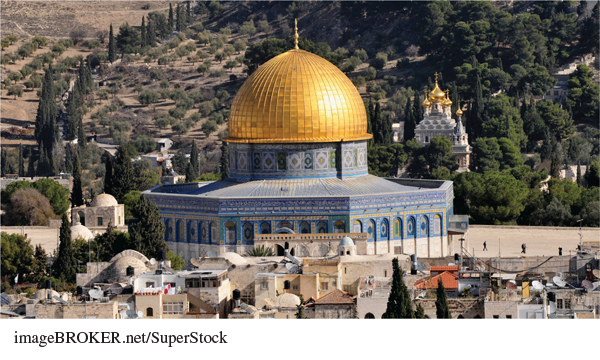A History of Western Society: Printed Page 222
A History of Western Society, Value Edition: Printed Page 209
A History of Western Society, Concise Edition: Printed Page 222
Chapter Chronology
The Teachings and Expansion of Islam
Page 222
Muhammad’s religion eventually attracted great numbers of people, partly because of the straightforward nature of its doctrines. The strictly monotheistic theology outlined in the Qur’an has only a few central tenets: Allah, the Arabic word for God, is all-powerful and all-knowing. Muhammad, Allah’s prophet, preached his word and carried his message. Muhammad described himself as the successor both of the Jewish patriarch Abraham and of Christ, and he claimed that his teachings replaced theirs. He invited and won converts from Judaism and Christianity.

Dome of the Rock, Jerusalem Completed in 691 and revered by Muslims as the site where Muhammad ascended to Heaven, the Dome of the Rock is the third-holiest place in Islam, after Mecca and Medina. Influenced by Byzantine and Persian architecture, it also has distinctly Arab features, such as Qur’anic inscriptions.
Because Allah is all-powerful, believers must submit themselves to him. All Muslims have the obligation of the jihad (literally, “self-exertion”) to strive or struggle to lead a virtuous life and to spread God’s rule and law. In some cases striving is an individual struggle against sin; in others it is social and communal and could involve armed conflict, though this is not an essential part of jihad (jee-HAHD). The Islamic belief of “striving in the path of God” is closely related to the central feature of Muslim doctrine, the coming Day of Judgment. Muslims believe with conviction that the Day of Judgment will come; consequently, all of a Muslim’s thoughts and actions should be oriented toward the Last Judgment and the rewards of Heaven.
To merit the rewards of Heaven, a person must follow the strict code of moral behavior that Muhammad prescribed. The Muslim must recite a profession of faith in God and in Muhammad as God’s prophet: “There is no god but God and Muhammad is his prophet.” The believer must pray five times a day, fast and pray during the sacred month of Ramadan, and contribute alms to the poor and needy. If possible, the believer must make a pilgrimage to Mecca once during his or her lifetime. According to the Muslim shari’a (shuh-REE-uh), or sacred law, these five practices — the profession of faith, prayer, fasting, giving alms to the poor, and pilgrimage to Mecca — constitute the Five Pillars of Islam.The Muslim who faithfully observes the laws of the Qur’an can hope for salvation.
The Qur’an forbids alcoholic beverages and gambling, as well as a number of foods, such as pork, a dietary regulation adopted from the Mosaic law of the Hebrews. It condemns business usury — that is, lending money at interest rates or taking advantage of market demand for products by charging high prices for them.
Polygyny, the practice of men having more than one wife, was common in Arab society before Muhammad, though for economic reasons the custom was limited to the well-to-do. The Qur’an limited the number of wives a man could have, however: “[Of] women who seem good in your eyes, marry but two, three, or four; and if ye still fear that ye shall not act equitably then only one” (Sura 4:3).
Page 223
The Qur’an sets forth a strict sexual morality and condemns immoral behavior on the part of men as well as women: “The whore and the fornicator: whip each of them a hundred times. . . . The fornicator shall not marry other than a whore; and the whore shall not marry other than a fornicator” (Sura 24:2–3).
The Qur’an also set out rules for inheritance:
Men who die and leave wives behind shall bequeath to them a year’s maintenance. . . . And your wives shall have a fourth part of what you leave, if you have no issue [offspring]; but if you have issue, then they shall have an eighth part. With regard to your children, God commands you to give the male the portion of two females. (Sura 4:11–12)
With respect to matters of property, Muslim women of the early Middle Ages had more rights than Western women. For example, a Muslim woman retained complete jurisdiction over one-third of her property when she married and could dispose of it in any way she wished. Women in most European countries and the United States did not gain these rights until the nineteenth century.
